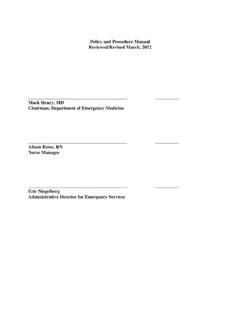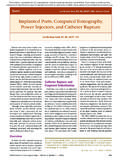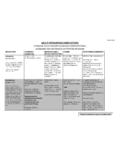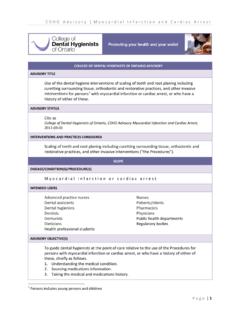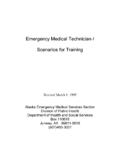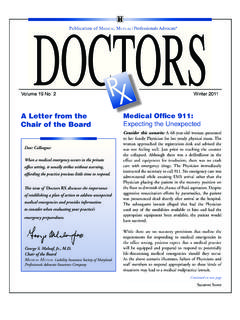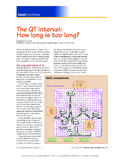Transcription of THERAPEUTIC HYPOTHERMIA PROTOCOL FOR …
1 Please Note: No order, PROTOCOL or guideline can anticipate every clinical circumstance, nor are they meant to substitute clinical assessment and judgment. THERAPEUTIC HYPOTHERMIA PROTOCOL FOR PATIENTS IMMEDIATELY POST CARDIAC ARREST 1. Patients who meet inclusion criteria post cardiac arrest should have their core body temperature reduced to 32 - 34 C as soon as possible, ideally within 4 hours of return of spontaneous circulation (ROSC). 2. If the patient is not already in an Intensive Care Unit (ICU) arrangements must be made to a transfer to the first available ICU bed. 3. One to one nursing care is required for any patient receiving THERAPEUTIC HYPOTHERMIA . 4. The patient s circulation must be maintained with a Systolic B/P > 90mm/HG and airway with 02 saturation of >90%. 5. The goal is to continue the THERAPEUTIC HYPOTHERMIA for a period of 24 hours from initiation of cooling. 6. Once 24 hours of cooling has occurred, a slow (passive) rewarming phase will be initiated to reach the goal temperature of Celsius.
2 It should happen no faster than an increase of C per hour. ISSUE INTERVENTIONS Inclusion criteria 1. All cardiac arrests in or out of the hospital with a probable down time < 15 minutes. 2. Return of spontaneous circulation (ROSC) within 45 minutes of the arrest. 3. No response to verbal commands 4. 18 years or older. Caution to consider 1. Pregnancy; obtain an immediate OB consult for recommendations 2. Systemic infection / unrecognized sepsis ( HYPOTHERMIA therapy may inhibit an immune response). 3. Recent major surgery within 14 days, a surgical consult may be required. 4. Known pre-existing coagulopathy or active or recent bleeding. 5. Contra-indicated as long as patient s temperature is already = or < 34 C post arrest. Continue to monitor using cooling and heating exchange devices to maintain core temperature between 32-34 C Exclusion Criteria 1. A known terminal illness preceding arrest or has a written DNR/DNI. 2. Pulse less > 60 minutes 3.
3 12 hrs. since Return of Spontaneous Circulation (ROSC) (Data suggest cooling patients as soon as possible post-cardiac arrest) 4. Glasgow Motor score >5 5. Minimal pre-morbid cognitive status 6. Other reason for coma intercranial pathology ( intracranial hemorrhage, ischemic stroke), subarachnoid hemorrhage (SAH), sedation. Please Note: No order, PROTOCOL or guideline can anticipate every clinical circumstance, nor are they meant to substitute clinical assessment and judgment. ISSUE INTERVENTIONS 7. Severe sepsis / septic shock as etiology for arrest 8. Uncontrollable bleeding 9. Significant trauma, especially intra-abdominal such as splenic or liver laceration (due to increased risk of bleeding) 10. Uncontrollable dysrhythmia Consults to obtain 1. If New ST elevation or New LBBB - call a STAT code H. 2. If EKG findings unclear or positive troponins, call Cardiology Consult 3. STAT Pulmonary consult for post arrest management, or for MICU acceptance in a non-code H patient.
4 4. Continuous EEG for first 24 hours 5. Neurology consult Equipment needed 1. Temperature probe for continuous monitoring of core body temperature (bladder & esophageal preferred, rectal if these are not possible) 2. Two liters of 4 Celsius normal saline Keep 2 liters chilled normal saline in ICU/ED med refrigerators while running the PROTOCOL . Two liters of chilled normal saline will arrive on non-ICU floors with replacement Code cart. Label the bag to expire in 24 hrs. 3. Pressure bags 4. Ice packs zip lock bags from code cart, ice from ice machine 5. THERAPEUTIC HYPOTHERMIA Cooling blankets(top and bottom sandwich) 6. Foley catheter 7. NG tube 8. Bladder lavage (to be used only if cooling process not successful within 15-30 minutes) 9. THERAPEUTIC HYPOTHERMIA Frequent Vital Sign sheet Cooling the Patient in the first 4 hours 1. Obtain a core temperature via esophageal, bladder or rectal temperature probe. If greater than 34 C, start THERAPEUTIC HYPOTHERMIA .
5 NOTE: Do not begin cooled infusion until cooling devices are assembled 2. Infuse two liters (bolus) 30ml/kg of 4 Celsius Normal Saline over 30 minutes using pressure bags to aid infusion through peripheral IV s. Avoid Internal Jugular or Subclavian central lines. A femoral line is acceptable. 3. Place ice packs at patient s neck, axilla and groin. 4. Place patient on THERAPEUTIC HYPOTHERMIA cooling blanket system. If using simple cooling-blanket system, place patient between 2 cooling blankets (sandwich), with sheets between the patient and the blanket. (Cooling machines are available in CICU, SICU, MICU and the ED. Use two extension hoses on one machine) OR Use an Automated loop-- feedback external pad--cooling system 5. Use an esophageal, bladder or rectal probe to monitor body temperature. 6. Record vital signs, PERRL and whether shivering is present on the designated THERAPEUTIC HYPOTHERMIA (TH) frequent vital sign sheet every 15 minutes for one hour, then every one hour.
6 7. Place a Foley catheter and NG tube 8. If NG lavage required: use ice cold water 250ml every 15-30 minutes until target temperature is reached. Watch pH. 9. Consider bladder lavage only if cooling is occurring too slowly; 200ml every 15-30 Please Note: No order, PROTOCOL or guideline can anticipate every clinical circumstance, nor are they meant to substitute clinical assessment and judgment. ISSUE INTERVENTIONS minutes. 10. Check skin surfaces every hour for cold burns, document integrity on TH frequent vital sign sheet. 11. Maintain a MAP > 80mmHg. 12. Maintain continuous cardiac monitoring with an EKG every 8 hours x 3 then once a day.*(see note). Refractory arrhythmias will require active rewarming. 13. Labs: On admission: Chem 8 w/ Mg/Ca/Phos, serial troponins, PT/PTT, amylase, lipase, lactic acid, ammonia, blood cultures, ABG (corrected to the temperature of the patient) Every 2 hours during cooling phase until target temperature is met: Chem 8 w/ Mg/Ca/Phos during cooling phase.
7 14. Maintain blood glucose at target range using the Adult Rapid Acting Insulin Order-Set 15. If blood glucose > 150mg/dL use the Adult ICU Regular Insulin Infusion Orders in power plan order set. 16. Lab values: Keep serum potassium > Keep Mg > Maintain blood glucoses < 150mg/dL 17. Sedate ventilated patients using the Richmond Agitation Scale (RASS) goal = (-4) Deep sedation. 18. Eliminate shivering through use of opiates, warming hands and feet and/or neuromuscular blocking agents. 19. Administer a paralytic ONLY if shivering is present: Do NOT paralyze a patient who is not intubated & adequately sedated Cooling the Patient from hour 4 to 24. 1. Record vital signs hourly 2. Maintain continuous cardiac monitoring observe for refractory arrhythmias. 3. EKG every 8 hours x 3 4. Obtain Neurology Consult 5. EEG Monitor I s & O s Notes on Shivering 1. Additional sedation / neuromuscular blockade may be needed to eliminate shivering. Note: Neuromuscular blockades should be avoided unless necessary due to potential abrupt drop in core temperature.
8 2. Shivering will generate heat and raise core temperature. 3. Shivering increases O2 consumption by 40-100% Clinical Consequences and Complications to look for 1. EKG: wide QRS, prolonged QT, Osborne waves, atrial fibrillation, refractory and VF <30 C Refractory arrhythmias requires active rewarming. 2. Oxygen delivery to tissues: bradycardia (HR 40-45) reduces by approx 25%, impaired unloading of O2 off hemoglobin, to core, increased ANP, cold diuresis hypovolemia, reduced metabolic rate, hyperlactatemia and metabolic acidosis. 3. Electrolyte imbalances Hypo K, Mg, P, Ca (due to tubular dysfunction and intracellular Please Note: No order, PROTOCOL or guideline can anticipate every clinical circumstance, nor are they meant to substitute clinical assessment and judgment. ISSUE INTERVENTIONS sequestration) do not over correct 4. Hyperglycemia: Insulin resistance and reduced insulin secretion - should be treated aggressively 5.
9 Increased amylase, LFT s 6. Decreased drug clearance by liver conjugation/oxidation, esp opiates, benzos, NM blockers 7. Incorrect ABG values: subtract 5mmHg for each 1 degree < 37 C 8. Hemorrhagic diathesis: low platelet # s and functions. Significant only in trauma patients. may use FFP & Platelelts. 9. Unrecognized sepsis patients may not mount an immune response. 10. Bedsores 11. Resuscitative medications and defibrillation may not work at temperatures < 30 What you may expect to see 1. Induced diuresis treat aggressively with fluid and electrolytes 2. Mg, Phos & K should be monitored closely at low normal. (They will rebound to high upon rewarming) Rewarming the Patient 1. Anticipate vasodilatation (afterdrop) & drop in BP with rewarming. Aggressively volume load with NaCl 6-8 hours prior to rewarming 2. Begin 24 hours after cooling is initiated 3. Rewarm body temperature passively by discontinuing cooling therapy to a goal of C at a rate of C / hour or 1 C every four hours.
10 4. Only if the goal temperature of C is not reached within 12 hours should a warm air blanket be used. 5. Monitor for rebound hyperthermia - Avoid temperatures > C, treat with medication or cooling blanket 6. Routine ICU vital signs. Call MD for SBP = < 90, HR < 40, potassium > 5 7. Continue to monitor and notify MD for arrhythmias, abnormal coagulation lab values, signs of infection, hypotension, hyperkalemia 8. Stop neuromuscular blocking agents if initiated 9. Titrate analgesics and sedative for patient sedation RASS (-2) REFERENCES: Perberd, M., Callaway, C., Neumar, R., (2001) Part 9: Post Cardiac Arrest Care: 2010 American Heart Association guidelines for Cardiopulmonary Resuscitation and Emergency Cardiovascular Care. Circulation 2010; 122; S768-S786. Retrieved October 21, 2010 from 122/18 suppl 3/S768 Sayer,M.,.Berg,R., (2010) American Heart Association Guidelines CPR ECC. Highlights of the 2010 American Heart Association Guidelines for CPR and ECC.

